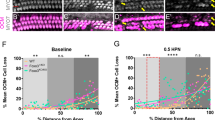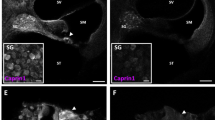Abstract
Various stressors, such as loud sounds and the effects of aging, impair the function and viability of the cochlear sensory cells, the hair cells. Stressors trigger pathophysiological changes in the cochlear non-sensory cells as well. We have here studied the stress response mounted in the lateral wall of the cochlea during acute noise stress and during age-related chronic stress. We have used the activation of JNK/c-Jun, ERK, and NF-κB pathways as a readout of the stress response, and the expression of the FoxO3 transcription factor as a possible additional player in cellular stress. In the aging cochlea, NF-κB transcriptional activity was strongly induced in the stria vascularis of the lateral wall. This induction was linked with the atrophy of the stria vascularis, suggesting a role for NF-κB signaling in mediating age-related strial degeneration. Acutely following noise exposure, the JNK/c-Jun, ERK, and NF-κB pathways were activated in the spiral ligament of the lateral wall of CBA/Ca mice. This activation was concomitant with the morphological transformation of macrophages, suggesting that the upregulation of stress signaling leads to macrophage activation. In contrast, C57BL/6J mice lacked these responses. Only the combination of noise exposure and a systemic stressor, lipopolysaccharide, exceeded the threshold for the activation of stress signaling in the lateral wall of C57BL/6J mice. In addition, we found that, at the young adult age, outer hair cells of CBA/Ca mice are much more vulnerable to loud sounds compared to these cells of C57BL/6J mice. These results suggest that the differential stress response in the lateral wall of the two mouse strains underlies, in part, the differential noise vulnerability of their outer hair cells. Together, we propose that the molecular stress response in the lateral wall modulates the outcome of the stressed cochlea.








Similar content being viewed by others
References
Adams JC, Seed B, Lu N, Landry A, Xavier RJ (2009) Selective activation of nuclear factor kappa B in the cochlea by sensory and inflammatory stress. Neuroscience 160:530–539. https://doi.org/10.1016/j.neuroscience.2009.02.073
Anttonen T, Herranen A, Virkkala J, Kirjavainen A, Elomaa P, Laos M, Xin-qun L, Ylikoski J, Behrens A, Pirvola U (2016) c-Jun N-terminal phosphorylation: biomarker for cellular stress rather than cellular death in the injured cochlea. eNeuro 3. https://doi.org/10.1523/ENEURO.0047-16.2016
Bhakar AL, Tannis LL, Zeindler C, Russo MP, Jobin C, Park DS, Macpherson S, Barker PA (2002) Constitutive nuclear factor-kB activity is required for central neuron survival. J Neurosci 22:8466–8475. https://doi.org/10.1523/JNEUROSCI.22-19-08466.2002
Bonizzi G, Karin M (2004) The two NF-kappaB activation pathways and their role in innate and adaptive immunity. Trends Immunol 25:280–288. https://doi.org/10.1016/j.it.2004.03.008
Fettiplace R (2017) Hair cell transduction, tuning, and synaptic transmission in the mammalian cochlea. Compr Physiol 7:1197–1227. https://doi.org/10.1002/cphy.c160049
Francis SP, Cunningham LL (2017) Non-autonomous cellular responses to ototoxic drug-induced stress and death. Front Cell Neurosci 11:252. https://doi.org/10.3389/fncel.2017.00252
Fredelius L, Rask-Andersen H (1990) The role of macrophages in the disposal of degeneration products within the organ of corti after acoustic overstimulation. Acta Otolaryngol 109:76–82. https://doi.org/10.3109/00016489009107417
Frye MD, Yang W, Zhang C, Xiong B, Hu BH (2017) Dynamic activation of basilar membrane macrophages in response to chronic sensory cell degeneration in aging mouse cochleae. Hear Res 344:125–134. https://doi.org/10.1016/j.heares.2016.11.003
Fujioka M, Kanzaki S, Okano HJ, Masuda M, Ogawa K, Okano H (2006) Proinflammatory cytokines expression in noise-induced damaged cochlea. J Neurosci Res 83:575–583. https://doi.org/10.1002/jnr.20764
Fulda S, Gorman AM, Hori O, Samali A (2010) Cellular stress responses: cell survival and cell death. Int J Cell Biol 214074:1–23. https://doi.org/10.1155/2010/214074
Gilels F, Paquette ST, Zhang J, Rahman I, White PM (2013) Mutation of Foxo3 causes adult onset auditory neuropathy and alters cochlear synapse architecture in mice. J Neurosci 33:18409–18424. https://doi.org/10.1523/JNEUROSCI.2529-13.2013
Gushchina S, Leinster V, Wu D, Jasim A, Demestre M, Lopez de Heredia L, Michael GJ, Barker PA, Richardson PM, Magoulas C (2009) Observations on the function of nuclear factor kappa B (NF-kappaB) in the survival of adult primary sensory neurons after nerve injury. Mol Cell Neurosci 40:207–216. https://doi.org/10.1016/j.mcn.2008.10.010
Han C, Linser P, Park H-J, Kim M-J, White K, Vann JM, Ding D, Prolla TA, Someya S (2016) Sirt1 deficiency protects cochlear cells and delays the early onset of age-related hearing loss in C57BL/6 mice. Neurobiol Aging 43:58–71. https://doi.org/10.1016/j.neurobiolaging.2016.03.023
Henderson D, Bielefeld EC, Harris KC, Hu BH (2006) The role of oxidative stress in noise-induced hearing loss. Ear Hear 27:1–19. https://doi.org/10.1097/01.aud.0000191942.36672.f3
Hequembourg S, Liberman MC (2001) Spiral ligament pathology: a major aspect of age-related cochlear degeneration in C57BL/6 mice. J Assoc Res Otolaryngol 2:118–129. https://doi.org/10.1007/s101620010075
Herdegen T, Claret F-X, Kallunki T, Martin-Villalba A, Winter C, Hunter T, Karin M (1998) Lasting N-terminal phosphorylation of c-Jun and activation of c-Jun N-terminal kinases after neuronal injury. J Neurosci 18:5124–5135. https://doi.org/10.1523/JNEUROSCI.18-14-05124.1998
Hirose K, Liberman MC (2003) Lateral wall histopathology and endocochlear potential in the noise-damaged mouse cochlea. J Assoc Res Otolaryngol 4:339–352. https://doi.org/10.1007/s10162-002-3036-4
Hirose K, Discolo CM, Keasler JR, Ransohoff R (2005) Mononuclear phagocytes migrate into the murine cochlea after acoustic trauma. J Comp Neurol 489:180–194. https://doi.org/10.1002/cne.20619
Hirose K, Li SZ, Ohlemiller KK, Ransohoff RM (2014) Systemic lipopolysaccharide induces cochlear inflammation and exacerbates the synergistic ototoxicity of kanamycin and furosemide. J Assoc Res Otolaryngol 15:555–570. https://doi.org/10.1007/s10162-014-0458-8
Hoffmann A, Baltimore D (2006) Circuitry of nuclear factor kappaB signaling. Immunol Rev 210:171–186. https://doi.org/10.1111/j.0105-2896.2006.00375.x
Jagger DJ, Forge A (2013) The enigmatic root cell—emerging roles contributing to fluid homeostasis within the cochlear outer sulcus. Hear Res 303:1e11–1e11. https://doi.org/10.1016/j.heares.2012.10.010
Jagger DJ, Nevill G, Forge A (2010) The membrane properties of cochlear root cells are consistent with roles in potassium recirculation and spatial buffering. J Assoc Res Otolaryngol 11:435–448. https://doi.org/10.1007/s10162-010-0218-3
Jassam YN, Izzy S, Whalen M, Mcgavern DB, El Khoury J (2017) Neuroimmunology of traumatic brain injury: time for a paradigm shift. Neuron 95:1246–1265. https://doi.org/10.1016/j.neuron.2017.07.010
Kikuchi T, Kimura RS, Paul DL, Takasaka T, Adams JC (2000) Gap junction systems in the mammalian cochlea. Brain Res Brain Res Rev 32:163–166. https://doi.org/10.1016/S0165-0173(99)00076-4
Kirjavainen A, Laos M, Anttonen T, Pirvola U (2015) The Rho GTPase Cdc42 regulates hair cell planar polarity and cellular patterning in the developing cochlea. Biol Open 4:516–526. https://doi.org/10.1242/bio.20149753
Koo JW, Quintanilla-Dieck L, Jiang M, Liu J, Urdang ZD, Allensworth JJ, Cross CP, Li H, Steyger PS (2015) Endotoxemia-mediated inflammation potentiates aminoglycoside-induced ototoxicity. Sci Transl Med 7(298). https://doi.org/10.1126/scitranslmed.aac5546
Kurioka T, Matsunobu T, Satoh Y, Niwa K, Endo S, Fujioka M, Shiotani A (2015) ERK2 mediates inner hair cell survival and decreases susceptibility to noise-induced hearing loss. Sci Rep 5:16839. https://doi.org/10.1038/srep16839
Laos M, Sulg M, Herranen A, Anttonen T, Pirvola U (2017) Indispensable role of Mdm2/p53 interaction during the embryonic and postnatal inner ear development. Sci Rep 7:42216. https://doi.org/10.1038/srep42216
Liu H, Li Y, Chen L, Zhang Q, Pan N, Nichols DH, Zhang WJ, Fritzsch B, He DZ (2016) Organ of corti and stria vascularis: is there an interdependence for survival? PLoS One 11:e0168953. https://doi.org/10.1371/journal.pone.0168953
Masuda M, Nagashima R, Kanzaki S, Fujioka M, Ogita K, Ogawa K (2006) Nuclear factor-kappa B nuclear translocation in the cochlea of mice following acoustic overstimulation. Brain Res 1068:237–247. https://doi.org/10.1016/j.brainres.2005.11.020
Müller M, von Hünerbein K, Hoidis S, Smolders JW (2005) Physiological place-frequency map of the cochlea in the CBA/J mouse. Hear Res 202:63–73. https://doi.org/10.1016/j.heares.2004.08.011
Nin F, Yoshida T, Sawamura S, Ogata G, Ota T, Higuchi T, Murakami S, Doi K, Kurachi Y, Hibino H (2016) The unique electrical properties in an extracellular fluid of the mammalian cochlea; their functional roles, homeostatic processes, and pathological significance. Pflugers Arch 468:1637–1649. https://doi.org/10.1007/s00424-016-1871-0
Ohlemiller KK (2009) Mechanisms and genes in human strial presbycusis from animal models. Brain Res 1277:70–83. https://doi.org/10.1016/j.brainres.2009.02.079
Ohlemiller KK, Gagnon PM (2007) Genetic dependence of cochlear cells and structures injured by noise. Hear Res 224:34–50. https://doi.org/10.1016/j.heares.2006.11.005
Ohlemiller KK, Jones SM, Johnson KR (2016) Application of mouse models to research in hearing and balance. JARO 17:493–523. https://doi.org/10.1007/s10162-016-0589-1
Ohlemiller KK, Kaur T, Warchol ME, Withnell RH (2018) The endocochlear potential as an indicator of reticular lamina integrity after noise exposure in mice. Hear Res 361:138–151. https://doi.org/10.1016/j.heares.2018.01.015
Okano T, Nakagawa T, Kita T, Kada S, Yoshimoto M, Nakahata T, Ito J (2008) Bone marrow-derived cells expressing Iba1 are constitutively present as resident tissue macrophages in the mouse cochlea. J Neurosci Res 86:1758–1767. https://doi.org/10.1002/jnr.21625
Papa S, Zazzeroni F, Pham CG, Bubici C, Franzoso G (2004) Linking JNK signaling to NF-κB: a key to survival. J Cell Sci 117:5197–5208. https://doi.org/10.1242/jcs.01483
Pirvola U, Xing-Qun L, Virkkala J, Saarma M, Murakata C, Camoratto AM, Walton KM, Ylikoski J (2000) Rescue of hearing, auditory hair cells, and neurons by CEP-1347/KT7515, an inhibitor of c-654 Jun N-terminal kinase activation. J Neurosci 20:43–50. https://doi.org/10.1523/JNEUROSCI.20-01-00043.2000
Schuknecht HF, Watanuki K, Takahashi T, Belal AA Jr, Kimura RS, Jones DD, Ota CY (1974) Atrophy of the stria vascularis, a common cause for hearing loss. Laryngoscope 84:1777–1821. https://doi.org/10.1288/00005537-197410000-00012
Shi X (2016) Pathophysiology of the cochlear intrastrial fluid-blood barrier. Hear Res 338:52–63. https://doi.org/10.1016/j.heares.2016.01.010
Shodo R, Hayatsu M, Koga D, Horii A, Ushiki T (2017) Three-dimensional reconstruction of root cells and interdental cells in the rat inner ear by serial section scanning electron microscopy. Biomed Res 38:239–248. https://doi.org/10.2220/biomedres.38.239
Spicer SS, Schulte BA (2005) Pathologic changes of presbycusis begin in secondary processes and spread to primary processes of strial marginal cells. Hear Res 205:225–240. https://doi.org/10.1016/j.heares.2005.03.022
Storz P (2011) Forkhead homeobox type O transcription factors in the responses to oxidative stress. Antioxid Redox Signal 14:593–605. https://doi.org/10.1089/ars.2010.3405
Sykes SM, Lane SW, Bullinger L, Kalaitzidis D, Yusuf R, Saez B, Ferraro F, Mercier F, Singh H, Brumme KM, Acharya SS, Scholl C, Tothova Z, Attar EC, Fröhling S, Depinho RA, Armstrong SA, Gilliland DG, Scadden DT (2011) AKT/FOXO signaling enforces reversible differentiation blockade in myeloid leukemias. Cell 146:697–708. https://doi.org/10.1016/j.cell.2011.07.032
Tahera Y, Meltser I, Johansson P, Bian Z, Stierna P, Hansson AC, Canlon B (2006) NF-kappaB mediated glucocorticoid response in the inner ear after acoustic trauma. J Neurosci Res 83:1066–1076. https://doi.org/10.1002/jnr.20795
Tilstra JS, Clauson CL, Niedernhofer LJ, Robbins PD (2011) NF-κB in aging and disease. Aging Dis 2:449–465. Retrieved from http://www.aginganddisease.org/EN/
Vethanayagam RR, Yang W, Dong Y, Hu BH (2016) Toll-like receptor 4 modulates the cochlear immune response to acoustic injury. Cell Death & Disease 7:e2245-e2245. https://doi.org/10.1038/cddis.2016.156
Waetzig V, Czeloth K, Hidding U, Mielke K, Kanzow M, Brecht S, Goetz M, Lucius R, Herdegen T, Hanisch UK (2005) c-Jun N-terminal kinases (JNKs) mediate pro-inflammatory actions of microglia. Glia 50:235–246. https://doi.org/10.1002/glia.20173
Wang Y, Hirose K, Liberman MC (2002) Dynamics of noise-induced cellular injury and repair in the mouse cochlea. J Assoc Res Otolaryngol 3:248–268. https://doi.org/10.1007/s101620020028
Wang J, Van De Water TR, Bonny C, de Ribaupierre F, Puel JL, Zine A (2003) A peptide inhibitor of c-Jun N-terminal kinase protects against both aminoglycoside and acoustic trauma-induced auditory hair cell death and hearing loss. J Neurosci 23:8596–8607. https://doi.org/10.1523/JNEUROSCI.23-24-08596.2003
Wangemann P (2002) K+ cycling and the endocochlear potential. Hear Res 165:1–9. https://doi.org/10.1016/S0378-5955(02)00279-4
Warchol ME (1997) Macrophage activity in organ cultures of the avian cochlea: demonstration of a resident population and recruitment to sites of hair cell lesions. J Neurobiol 33:724–734. https://doi.org/10.1002/(SICI)1097-4695(19971120)33:6<724::AID-NEU2>3.0.CO;2-B
Yamaguchi T, Nagashima R, Yoneyma M, Shiba T, Ogita K (2014) Disruption of ion-trafficking system in the cochlear spiral ligament prior to permanent hearing loss induced by exposure to intense noise: possible involvement of 4-hydroxy-2-nonenal as a mediator of oxidative stress. PLoS One 9:e102133. https://doi.org/10.1371/journal.pone.0102133
Acknowledgements
We are grateful to Drs P. Barker and M. Mikkola for sharing the NF-κB/LacZ reporter mice with us, and Sanna Sihvo for excellent technical assistance.
Funding
This work was financially supported by Jenny and Antti Wihuri Foundation, Doctoral Programme Brain & Mind University of Helsinki, Instrumentarium Science Foundation, Päivikki and Sakari Sohlberg Foundation, Maud Kuistila Foundation, Kuuloliitto ry, and Finnish Association of Otorhinolaryngology and Head and Neck Surgery.
Author information
Authors and Affiliations
Corresponding author
Ethics declarations
The animal experiments were conducted following relevant guidelines for animal work and approved by the National Animal Experiment Board.
Conflict of Interest
The authors declare that they have no conflict of interest.
Rights and permissions
About this article
Cite this article
Herranen, A., Ikäheimo, K., Virkkala, J. et al. The Stress Response in the Non-sensory Cells of the Cochlea Under Pathological Conditions—Possible Role in Mediating Noise Vulnerability. JARO 19, 637–652 (2018). https://doi.org/10.1007/s10162-018-00691-2
Received:
Accepted:
Published:
Issue Date:
DOI: https://doi.org/10.1007/s10162-018-00691-2




